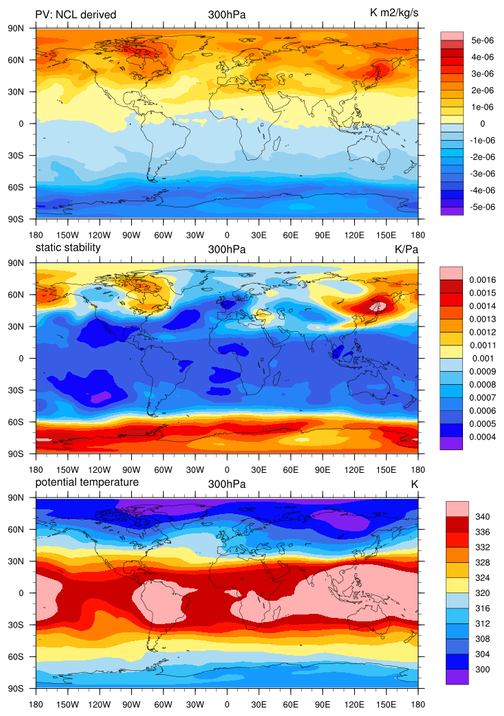NCL Home>
Application examples>
Data sets ||
Data files for some examples
Example pages containing:
tips |
resources |
functions/procedures
NCL: Potential Vorticity on Isobaric/Hybrid Levels; Static Stability; Potential Temperature
Potential Vorticity (PV); Static Stability; Potential Temperature
There are two potential vorticity (PV) functions in NCL. One for application on hybrid (model) levels
(
pot_vort_hybrid); the other for application on isobaric levels
(
pot_vort_isobaric). Embedded within these functions are functions to derive
static stability and
potential temperature.
Several of the functions have an option for multiple results to be returned as part of a list variable.
References:
Compute Potential Vorticity on Isobaric Levels:
Bluestein: Synoptic-Dynamic Meteorology in Midlatitudes pg 264 Eq 4.5.93
Compute Isentropic Potential Vorticity on Hybrid Levels:
CCM Processor User's Guide: May 1994: page B-19
Original source P Rasch and B Boville
Note: A nice basic discussion of PV may be found at:
Mid-Latitude Atmospheric Dynamics: A First Course
Jonathan E. Martin, Wiley 2006, QC880.M36 , pp276-onward
The data sets used are
ERA40 monthly mean files available from NCAR's Research Data Archive (RDA):
http://rda.ucar.edu/datasets/ds126.1/.
PV is a non-linear quantity. Hence, the correct way to compute monthly mean PV is to compute it
every time step and average the results. Computing PV from monthly mean U, V, T quantities will
result in smooth results that may compare well in terms of patterns but will likely lack the detailed
structure of the 'correct' monthly mean PV.


 pv_isobaric_1.ncl
pv_isobaric_1.ncl:
The top of each figure are the derived potential vorticity (PV) from
pot_vort_isobaric.
The bottom are the monthly mean PV provided by ERA40 which was calculated
at ECMWF the 'correct' way. Hence, each has more structure.
The NCL derived PV reflects that monthly mean U, V, T were used.
If NCL's function was used on the (say) 6-hrly values and averaged, the
results would likely mimic the ERA40 results.
 pv_isobaric_2.ncl
pv_isobaric_2.ncl:
This example illustrates how to retrieve individual elements from a list variable
returned by the
pot_vort_isobaric function.
Here,
static stability and
potential temperature are extracted.







